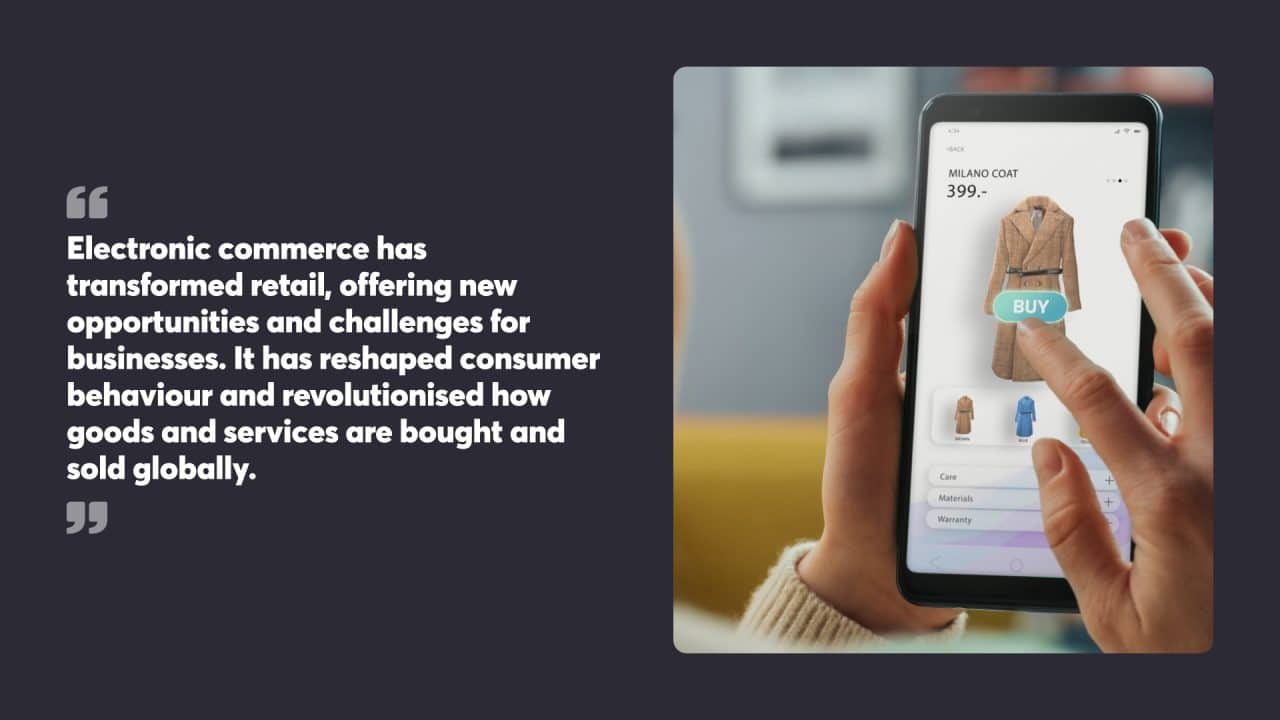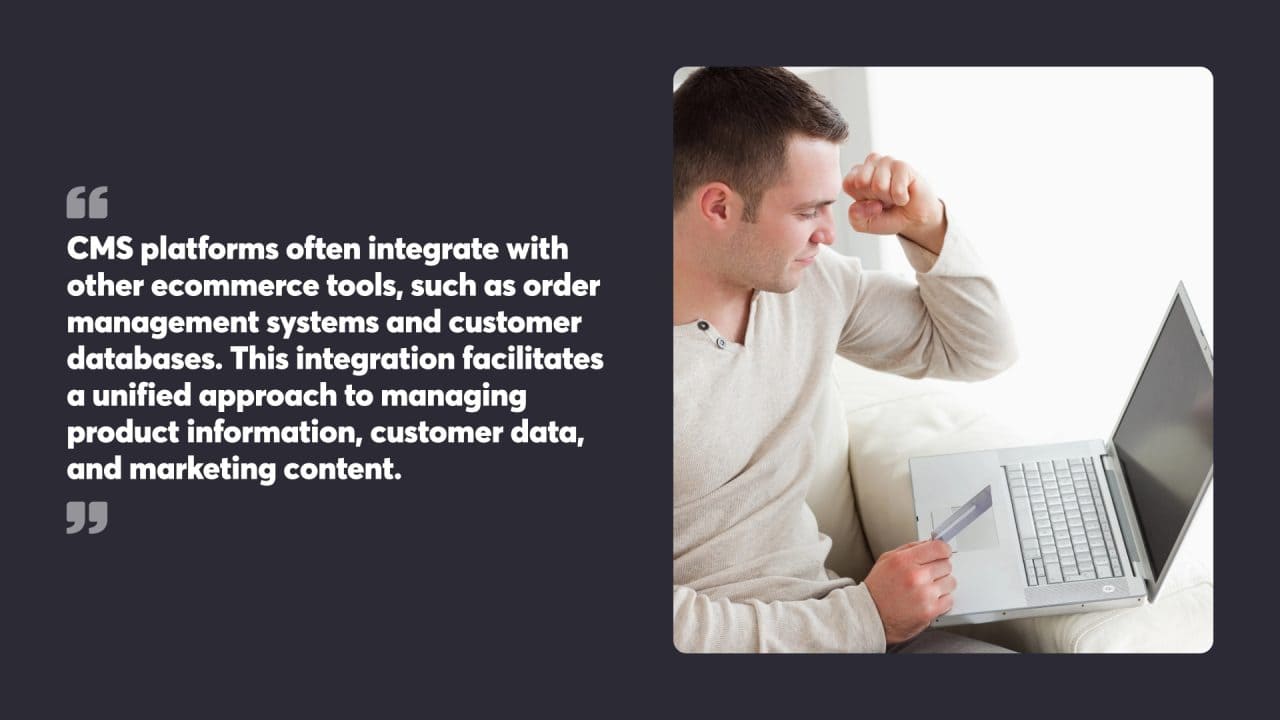
E-commerce web solutions have revolutionised the way businesses sell products and services online. These digital platforms enable companies to reach a global audience, operate 24/7, and provide convenient shopping experiences for customers.
The significance of ecommerce sales in the modern retail environment cannot be overstated, as it is essential for brands looking to thrive both offline and online. Additionally, the right ecommerce software plays a crucial role in enhancing business operations by providing convenience and accessibility for selling goods and services online.
From small startups to large corporations, e-commerce solutions offer tools to create online stores, manage inventory, process payments, and analyse sales data. They provide the infrastructure needed to showcase products, handle transactions securely, and deliver goods to customers worldwide.
Implementing an e-commerce solution involves selecting the right platform, designing a user-friendly interface, and integrating payment gateways. It also requires strategies for digital marketing, customer service, and order fulfilment. With the proper setup, businesses can tap into the growing online retail market and create new revenue streams…
Key Takeaways
- Global Reach and 24/7 Accessibility: E-commerce solutions empower businesses to operate around the clock and reach customers worldwide, breaking the limitations of physical storefronts and enabling continuous sales.
- Comprehensive Tools for Business Growth: From inventory management to secure payment processing and sales analytics, e-commerce platforms provide an all-in-one infrastructure that supports businesses of all sizes in creating, managing, and optimising their online stores.
- Strategic Implementation for Success: Successfully implementing an e-commerce solution involves selecting the right platform, designing a user-friendly interface, integrating payment gateways, and employing effective digital marketing strategies to attract and retain customers.

Table of Contents
Understanding E-commerce Business
Electronic commerce has transformed retail, offering new opportunities and challenges for businesses. It has reshaped consumer behaviour and revolutionised how goods and services are bought and sold globally.
The Rise of the Online Store
Online stores have grown rapidly in recent years. This growth stems from increased internet access, mobile device usage, and changing consumer preferences. E-commerce businesses can reach customers worldwide, operate 24/7, and offer a wider range of products than physical shops.
Many traditional retailers have expanded into e-commerce to stay competitive. Amazon, eBay, and Shopify have become major players in the online retail space. Small businesses and entrepreneurs can now easily set up online shops using platforms like WooCommerce or Squarespace.
E-commerce sales continue to climb each year. In 2020, the COVID-19 pandemic accelerated this trend as more people shopped online due to lockdowns and safety concerns. Projected growth statistics for global retail ecommerce sales underline the necessity for businesses to establish a robust online presence and select the right ecommerce platform to cater to consumer demand for online shopping.
Differences Between Physical and Digital Storefronts
Physical and digital storefronts have distinct characteristics that affect how businesses operate and interact with customers. Unlike a physical store, which requires monitoring and has restricted operating hours, digital storefronts offer convenience and accessibility. Customers can shop from anywhere at any time. Online stores typically have lower operating costs than physical shops. They can stock a broader range of items without needing large storage spaces.
Brick-and-mortar stores allow customers to see and touch products before buying. They can provide immediate gratification and face-to-face customer service.
E-commerce sites use data analytics to personalise the shopping experience. They can track customer behaviour and preferences to offer targeted recommendations. Physical stores are starting to adopt similar technologies, like beacons and smart shelves, to bridge the gap with online retail.

Choosing an Ecommerce Platform
Selecting the right ecommerce platform is crucial for online business success. Setting up an ecommerce storefront quickly and effectively is essential to meet the various needs and skills required for different types of ecommerce solutions. Different options offer varied features, pricing models, and levels of customisation to suit diverse needs.
Software as a Service (SaaS) compared to Custom Solutions
SaaS ecommerce platforms provide ready-made solutions with pre-built features and templates. They’re quick to set up and often include hosting, security, and updates. SaaS solutions are particularly suitable for market and enterprise brands, as they facilitate a quick and affordable go-to-market process while offering flexibility in customisation and integration. Popular SaaS options include Shopify, BigCommerce, and Wix Stores.
Custom solutions involve building an ecommerce website from scratch or heavily modifying existing platforms. This approach offers greater flexibility and control over functionality and design. However, it requires more time, technical expertise, and ongoing maintenance.
SaaS platforms suit businesses seeking rapid deployment and minimal technical involvement. Custom solutions benefit organisations with unique requirements or complex integrations.
Marketplace-Hosted vs Self-Hosted Options
Marketplace-hosted platforms like Amazon and eBay allow businesses to sell products on established marketplaces. These options provide access to large customer bases and handle many technical aspects.
Self-hosted platforms give businesses full control over their online stores. Options like WooCommerce and Magento allow for extensive customisation and data ownership. They require more technical knowledge and responsibility for hosting, security, and maintenance.
Marketplace-hosted solutions suit businesses looking for simplicity and exposure. Self-hosted platforms benefit those wanting complete control and scalability.
When choosing between these options, consider factors such as budget, technical skills, desired features, and long-term business goals.
Web Development for Online Retail
E-commerce web development focuses on creating functional and user-friendly online stores. Choosing the right ecommerce website development services is crucial to ensure that the developer’s skills align with ecommerce web design needs, enhancing user experience and conversion rates. It involves implementing essential features and ensuring compatibility across devices.
Core Features of Ecommerce Sites
E-commerce sites require specific components to operate effectively. Product catalogues allow businesses to showcase their offerings with detailed descriptions and high-quality images. Shopping carts enable customers to select and store items before purchase. Secure payment gateways are crucial for processing transactions safely.
Search functionality helps users find products quickly. Customer accounts allow for personalised experiences and order tracking. Reviews and ratings build trust and aid decision-making. Inventory management systems keep stock levels updated in real time.
Analytics tools provide insights into customer behaviour and sales trends. These features work together to create a smooth shopping experience and drive conversions.
Mobile Responsiveness and Cross-Platform Compatibility
With the rise of mobile shopping, e-commerce sites must adapt to different screen sizes and devices. Responsive design adjusts layout and content automatically based on the user’s device. This approach improves usability and reduces bounce rates.
Cross-platform compatibility extends beyond smartphones to include tablets, desktops, and even smart TVs. Developers test sites across various browsers and operating systems to catch and fix display issues.
Page load speed is critical for mobile users. Optimisation techniques like image compression and code minification help reduce loading times. Progressive web apps offer app-like experiences without requiring downloads, combining the best of mobile and web technologies.

Optimising Your Ecommerce Store
Effective optimisation strategies boost online store performance and sales. Key areas to focus on include search engine optimisation and digital marketing techniques.
Search Engine Optimisation (SEO)
SEO improves an ecommerce site’s visibility in search results. This drives more organic traffic and potential customers. Keyword research forms the foundation of SEO efforts. It reveals terms shoppers use when looking for products.
On-page optimisation involves refining product titles, descriptions, and meta tags. These should include relevant keywords naturally. Creating high-quality, unique content for product pages and blog posts also helps rankings.
Technical SEO factors like site speed and mobile-friendliness are crucial. Fast-loading pages keep visitors engaged and reduce bounce rates. A responsive design ensures a good experience across all devices.
Building quality backlinks from reputable sites boosts domain authority. This can be achieved through guest posting, partnerships, or creating shareable content.
Utilising Digital Marketing and SEM
Digital marketing encompasses various tactics to promote an online store. Search Engine Marketing (SEM) involves paid advertising on search platforms. This can quickly increase visibility for specific keywords.
Social media marketing builds brand awareness and engages customers. Platforms like Facebook and Instagram offer targeted advertising options. These allow businesses to reach specific demographics.
Email marketing remains a powerful tool for ecommerce. Personalised campaigns can nurture leads and encourage repeat purchases. Segmenting email lists helps deliver relevant content to different customer groups.
Content marketing attracts and retains customers through valuable information. Blog posts, videos, and infographics can showcase products and address customer pain points.
Analytics tools track the performance of marketing efforts. This data guides future strategies and helps optimise ad spend.

Payment and Security Mechanisms
E-commerce platforms require robust payment processing and stringent security measures to protect customer data and financial transactions. These systems form the backbone of online retail operations.
Integrating Multiple Payment Gateways
E-commerce sites benefit from offering various payment options to customers. Credit cards, debit cards, digital wallets, and PayPal are common choices. Integrating multiple payment gateways allows businesses to cater to diverse customer preferences and reach a wider market.
Payment gateway integration involves connecting the e-commerce platform with different payment processors. This setup enables secure transmission of transaction data between the customer, merchant, and financial institutions. Each gateway typically has its own API and integration requirements.
Businesses should consider factors like transaction fees, supported currencies, and geographical availability when selecting payment gateways. Popular options include PayPal, Stripe, and Square. Regular testing and monitoring of payment systems help maintain smooth operations and identify any issues promptly.
Addressing Data Security Concerns
Data security is paramount in e-commerce to protect sensitive customer information and maintain trust. Implementing strong encryption protocols for data transmission and storage is essential. SSL/TLS certificates secure communications between customers and the website.
PCI DSS compliance is mandatory for businesses handling credit card information. This standard sets requirements for secure data storage, network configuration, and regular security audits. Tokenisation replaces sensitive data with unique identifiers, reducing the risk of data breaches.
Two-factor authentication adds an extra layer of security for user accounts. Regular software updates and security patches help protect against emerging threats. Employee training on data handling best practices is crucial to prevent internal security breaches.
Mitigating Fraud-related Financial Consequences
Fraud prevention is critical for e-commerce businesses to avoid financial losses and maintain customer trust. Implementing fraud detection systems that analyse transaction patterns and flag suspicious activities is essential. Address verification services and CVV checks help verify the legitimacy of card transactions.
Setting transaction limits and monitoring for unusual buying behaviour can prevent large-scale fraud attempts. IP geolocation tools can identify transactions from high-risk regions. Requiring strong passwords and implementing account lockouts after multiple failed login attempts helps protect user accounts.
Clear refund and chargeback policies, along with efficient customer support, can reduce the impact of fraudulent claims. Businesses should stay informed about emerging fraud techniques and regularly update their prevention strategies. Collaborating with payment providers and banks can provide additional layers of fraud protection.

Ecommerce Content Management
Ecommerce content management involves creating, organising, and maintaining digital content for online stores. It plays a vital role in driving sales and enhancing the customer experience.
The Role of a Content Management System (CMS)
A content management system (CMS) serves as the backbone of ecommerce content management. It allows businesses to create, edit, and publish digital content without extensive technical knowledge. A good CMS streamlines workflows, enabling teams to collaborate efficiently.
CMS platforms often integrate with other ecommerce tools, such as order management systems and customer databases. This integration facilitates a unified approach to managing product information, customer data, and marketing content.
Some CMS platforms offer features like version control and content scheduling. These tools help maintain consistency across the site and allow for timely updates during sales or promotions.
Creating Detailed Product Descriptions
Detailed product descriptions are essential for ecommerce success. They provide customers with the information they need to make informed purchasing decisions. Well-crafted descriptions can boost search engine rankings and reduce returns.
When writing product descriptions, focus on:
- Key features and benefits
- Accurate specifications
- High-quality images and videos
- Customer reviews and ratings
Use clear, concise language and avoid jargon. Structure descriptions with bullet points or short paragraphs for easy scanning. Include relevant keywords naturally to improve search visibility.
Consider using AI-powered tools to generate consistent product descriptions at scale. These tools can help maintain quality while saving time and resources.

Strategies for Customer Engagement
Effective customer engagement drives e-commerce success through targeted marketing, improved shopping experiences, and trust-building measures.
Developing a Global Marketing Approach
Global marketing strategies help e-commerce businesses reach customers worldwide. Companies can localise content and adapt to cultural nuances to connect with diverse audiences. This involves translating websites and product descriptions into multiple languages and adjusting marketing messages to suit local preferences.
Social media platforms play a crucial role in global outreach. Businesses can create region-specific social media accounts to share tailored content and engage with customers in their preferred language. Influencer partnerships can further boost brand visibility in different markets.
Data analytics tools help track customer behaviour across regions, allowing businesses to refine their marketing strategies. By analysing purchase patterns and engagement rates, companies can identify which products and promotions resonate best in specific markets.
Enhancing the Online Shopping Experience
A smooth online shopping experience is vital for customer satisfaction and retention. Selling online is a versatile approach for various businesses to generate revenue, allowing entrepreneurs and established retailers to utilise online channels, including social media and dedicated websites, to reach customers and supplement their income. User-friendly website design with clear navigation and fast loading times is essential. Mobile optimisation is equally important, as many customers shop on smartphones and tablets.
Personalisation technology can enhance the shopping experience by recommending products based on browsing history and past purchases. This can increase sales and make customers feel valued.
Clear product descriptions, high-quality images, and customer reviews help shoppers make informed decisions. Virtual try-on features for clothing and makeup items can reduce uncertainty and boost confidence in purchases.
Streamlined checkout processes with multiple payment options and guest checkout facilities can reduce cart abandonment rates. Order tracking and easy returns policies further improve the overall shopping experience.
Establishing Customer Confidence and Trust
Building trust is paramount in e-commerce. Clear privacy policies and secure payment gateways are fundamental. Displaying security badges and SSL certificates can reassure customers about the safety of their personal and financial information.
Transparent pricing, including all fees and shipping costs upfront, prevents unpleasant surprises at checkout. Honest product descriptions and accurate stock information help set realistic expectations.
Responsive customer service through multiple channels, such as live chat, email, and phone support, shows commitment to customer satisfaction. Promptly addressing queries and complaints can turn potentially negative experiences into positive ones.
User-generated content, such as customer photos and reviews, provides social proof and builds trust. Encourage satisfied customers to share their experiences and respond professionally to both positive and negative feedback.
The Online Purchasing Process
The online purchasing process involves several key steps for customers and businesses. It encompasses streamlined checkout experiences and efficient inventory management systems.
Streamlining Customer Purchase Flows
E-commerce stores focus on creating smooth purchasing flows. They design user-friendly interfaces that guide shoppers through product selection and checkout. Clear product descriptions, high-quality images, and customer reviews help buyers make decisions.
Secure payment gateways protect financial information during transactions. Many stores offer multiple payment options, including credit cards, digital wallets, and buy-now-pay-later services.
One-click purchasing and guest checkout options speed up the process for repeat and new customers. Mobile optimisation allows for shopping on smartphones and tablets.
Managing Inventory and Order Fulfilment
Effective inventory management is vital for online businesses. Real-time stock tracking systems prevent overselling and backorders. Automated reordering processes maintain stock levels without manual intervention.
Order fulfilment starts as soon as a purchase is made. Integrated systems send order details to warehouses for picking and packing. Shipping partners receive electronic notifications for swift delivery.
Returns management is another key aspect. Clear policies and streamlined processes for returns and exchanges improve customer satisfaction. Some businesses use automated systems to handle refunds and track returned items.

Growing Your Ecommerce Enterprise
Expanding an online business requires strategic approaches to increase sales and reach new customers. Effective growth strategies can help ecommerce enterprises boost revenue and market share.
Leveraging Subscription Services and Add-ons
Subscription models offer steady income streams for ecommerce businesses. By providing recurring deliveries of products, companies can build customer loyalty and predict revenue. Popular subscription types include replenishment services for everyday items, curated boxes of new products, and access to exclusive content or perks.
Add-ons complement main products and boost average order values. Businesses can suggest related items during checkout or create bundles. For example, a laptop seller might offer cases, extended warranties or software packages. Upselling and cross-selling techniques help maximise sales from existing customers.
Attracting More Customers Beyond Business Hours
Automated systems allow ecommerce sites to keep selling 24/7. Chatbots can answer common questions and guide shoppers when human staff are unavailable. Self-service options like size guides and product comparison tools help customers make decisions independently.
Social media scheduling tools let businesses post content and ads at optimal times, even outside work hours. Email marketing automation sends personalised messages based on customer behaviour. By leveraging technology, online stores can engage shoppers and generate sales around the clock.
Mobile optimisation is crucial, as many consumers browse and buy via smartphones in the evenings. A responsive website design and user-friendly mobile app can capture sales from on-the-go customers at any time of day.

Ecommerce Site Infrastructure
The foundation of an ecommerce website relies on a solid infrastructure. This encompasses web hosting services and software-as-a-service (SaaS) platforms that support online store operations.
Selecting the Right Web Hosting Services
Web hosting is crucial for ecommerce websites. It affects site speed, security, and uptime. Shared hosting suits small businesses with low traffic. Virtual Private Servers (VPS) offer more resources and control. Dedicated servers provide maximum performance for high-traffic sites.
Cloud hosting is popular for its scalability. It allows businesses to adjust resources based on demand. This flexibility is valuable during sales peaks.
Security features are vital. Look for hosts offering SSL certificates, firewalls, and regular backups. These protect customer data and maintain trust.
Reliability is key. Choose a host with a strong uptime guarantee. 99.9% uptime or higher is ideal for ecommerce.
Accessing SaaS to Expand Ecommerce Offerings
SaaS platforms streamline ecommerce operations. They provide ready-to-use solutions for various business needs.
Shopping cart software is a core SaaS offering. It manages product catalogues, orders, and payments. Popular options include Shopify and WooCommerce.
Customer Relationship Management (CRM) systems help track customer interactions. They improve personalisation and service quality.
Inventory management software keeps stock levels accurate. It prevents overselling and stockouts.
Payment gateways are essential SaaS tools. They process transactions securely. PayPal and Stripe are common choices.
Analytics platforms offer insights into customer behaviour. They help optimise marketing and sales strategies.
If you have any questions about how Chillybin can help you launch or grow your eCommerce business, make sure you contact us today.




